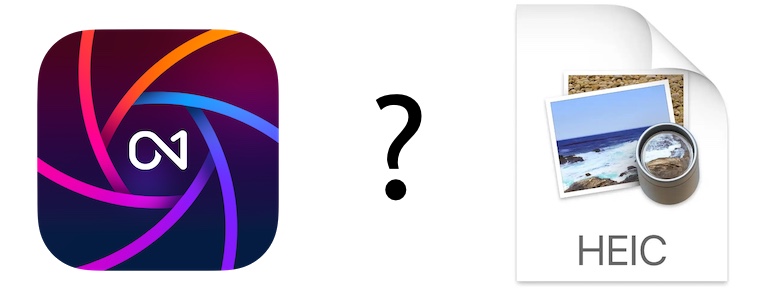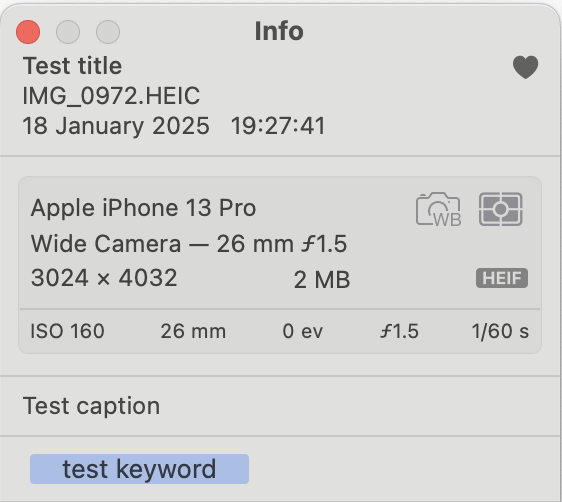
This article is about how On1 Photo RAW handles HEIC files and whether it can be efficiently used to manage a library of HEIC files.
This is not a full review of On1 Photo RAW which I’ve been using for a few years and found quite powerful both for RAW editing and photo library management. In this article I will explore a very specific use case concerning HEIC where – spoiler – it does not perform as well.
I shoot HEIC with my iPhone and once a year export part of the Photos library. I wrote about it in this article Is there a way out of iCloud Photos?. As I already have On1 Photo RAW I want to use it to manage these photos as well. Let’s see how good it is in handling HEIC.
What is HEIC and why should I care?
HEIC (or HEIF, HEIC being Apple’s version of HEIF) is a new image format that offers better compression than JPEG while preserving the same visual quality, as well as other advantages such as the possibility to code colors in more than 8 bits (i.e. more colors).
Apple introduced HEIC on its devices in 2017 (e.g. for photos taken with iPhone), so today it is widely used in the Apple ecosystem. However, HEIC is less present in Windows and Linux communities. Android supports HEIC since Android 10. Overall, JPEG offers much wider compatibility.
Being an Apple user, I want to keep my photos in HEIC and not convert to JPEG:
- Equivalent quality JPEGs would take twice the space (apparently).
- Reencoding takes time.
- Reencoding degrades image quality (both HEIC and JPEG use lossy compression).
Does On1 support HEIC at all?
Well, that’s a good question to start with. The answer is luckily yes but with some caveats.
The official website says that On1 Proto RAW 2025[1] supports Apple HEIC (and this has been the case since the 2019 version). I will not go into the subtleties of HEIC vs. HEIF but I can tell you this: FujiFilm’s latest version of HIF cannot be read for now.
And the biggest caveat of all is that it does not export HEIC.
Does On1 read metadata from HEIC?
The answer is kind of yes but with even more caveats. It’s hard to find any official communication from On1 on this specific subject. It appears that metadata handling for HEIC files is less comprehensive compared to other formats like RAW, JPEG, or TIFF.
ON1 appears to read the following embedded metadata from HEIC files:
- EXIF: camera make and model, lens information, exposure settings (shutter speed, aperture, ISO, etc.), focal length, date and time of capture, GPS location data.
- IPTC: title, caption, and description, keywords, creator (photographer name), copyright information.
- Color Profiles: embedded color space (e.g., sRGB or P3).
In my experience, EXIF works fine (see some details on date and time below). On the other hand, I had some struggles with IPTC, e.g. keywords. In the same batch of photos, Photo RAW would not read keywords for some of them. This seemed random but actually wasn’t since I was able to reproduce such behavior. I tried pretty much everything including resetting Photo RAW! The solution came unexpectedly: it appears that once any metadata has been ‘touched’ by Adobe Bridge (like setting a star rating), Photo RAW can read all IPTC without any issues. I have absolutely no idea why it works, I checked that Adobe Bridge does not modify dc:subject or add any other tags containing keywords.
Finally, Photo RAW does not write (embed) metadata in HEIC images.
For now, ON1 does not read nor write metadata from separate XMP sidecar files for HEIC images. This has been confirmed to me by their helpdesk.
Date and time
I have already posted on how date/time metadata is all but straightforward here link. In a nutshell, there are three metadata standards (EXIF, IPTC and XMP) that coexist, use different date/time formats, are inconsistently named and provide a set of tags to describe the following events:
- Date/time original specifies when a photo was taken,
- Date/time digitized specifies when an image was digitized,
- Date/time modified specifies when a file was modified by the user.

Digital cameras can use any of these tags to embed date/time in the image file. EXIF seems to be the preferred way to go for digital camera manufacturers. For example, a photo taken with an iPhone (iOS 18) contains the following tags:
% exiftool -s -G1 -time:all ~/Pictures/IMG_0011.HEIC
[IFD0] ModifyDate : 2024:12:06 12:55:50
[ExifIFD] DateTimeOriginal : 2024:12:06 12:55:50
[ExifIFD] CreateDate : 2024:12:06 12:55:50
[ExifIFD] OffsetTime : +01:00
[ExifIFD] OffsetTimeOriginal : +01:00
[ExifIFD] OffsetTimeDigitized : +01:00
[ExifIFD] SubSecTime : 215
[ExifIFD] SubSecTimeOriginal : 215
[ExifIFD] SubSecTimeDigitized : 215
[GPS] GPSTimeStamp : 11:55:49
[GPS] GPSDateStamp : 2024:12:06
[XMP-photoshop] DateCreated : 2024:12:06 12:55:50+01:00Note: the screenshot above is produced with exiftool (https://exiftool.org/) which uses its own tags, so don’t be confused.The way software interprets all this information is not subject to any standard. So, what does On1 read, exactly? Most often all three date/time events are the same and guidelines recommend to populate EXIF, IPTC and XMP with the same values for a very obvious reason. But what happens if this is not true or if some of the tags are missing?
Based on my testing, On1 reads from exif:DateTimeOriginal, and if it is unavailable, from exif:DateTime (which is a modification date) and puts the value in its internal Capture date. It reads from exif:DateTime even if there is a photoshop:DateCreated key, which is ignored.
If neither exif:DateTimeOriginal nor exif:DateTime are available On1 can’t get any value for which means that exif:DateTimeDigitized is ignored.
How does On1 write date/time data? We can’t test it with a HEIC file because On1 does not write metadata into HEIC and it does not write XMP sidecars for HEIC images neither (see below).
When it is able to write metadata natively, e.g. in a jpeg, it writes its internal Capture date in exif:DateTimeOriginal, exif:DateTime, exif:OffsetTimeOriginal, exif:OffsetTime, IPTC:DateCreated, IPTC:TimeCreated.
I first converted the HEIC image to JPEG. Note that IPTC tags were added, while photoshop:DateCreated was removed.
% exiftool -s -G1 -time:all ~/Pictures/IMG_0014.jpeg
[IFD0] ModifyDate : 2024:05:06 19:52:39
[ExifIFD] DateTimeOriginal : 2024:05:06 19:52:39
[ExifIFD] CreateDate : 2024:05:06 19:52:39
[ExifIFD] OffsetTime : +02:00
[ExifIFD] OffsetTimeOriginal : +02:00
[ExifIFD] OffsetTimeDigitized : +02:00
[ExifIFD] SubSecTimeOriginal : 131
[ExifIFD] SubSecTimeDigitized : 131
[GPS] GPSTimeStamp : 17:52:38
[GPS] GPSDateStamp : 2024:05:06
[ICC-header] ProfileDateTime : 2022:01:01 00:00:00
[IPTC] DigitalCreationTime : 19:52:39
[IPTC] DigitalCreationDate : 2024:05:06
[IPTC] DateCreated : 2024:05:06
[IPTC] TimeCreated : 19:52:39I then changed the capture date (set year to 2021) in On1 (Photo -> Edit Capture date) and embedded metadata (Photo -> Embed Metadata).
% exiftool -s -G1 -time:all ~/Pictures/IMG_0014.jpeg
[ExifIFD] ModifyDate : 2021:05:06 19:52:39
[ExifIFD] DateTimeOriginal : 2021:05:06 19:52:39
[ExifIFD] CreateDate : 2024:05:06 19:52:39
[ExifIFD] OffsetTime : 02:00
[ExifIFD] OffsetTimeOriginal : 02:00
[ExifIFD] OffsetTimeDigitized : +02:00
[ExifIFD] SubSecTimeOriginal : 131
[ExifIFD] SubSecTimeDigitized : 131
[GPS] GPSTimeStamp : 17:52:38
[GPS] GPSDateStamp : 2024:05:06
[XMP-xmp] MetadataDate : 2025:01:23 15:23:41+01:00
[ICC-header] ProfileDateTime : 2022:01:01 00:00:00
[IPTC] DateCreated : 2021:05:06
[IPTC] TimeCreated : 19:52:39+00:00The result was a combination of good and less good:
- Exif:DateTimeOriginal and Exif:ModifyDate (aka DateTime) are set to 2021 correctly.
- Exif:CreateDate (aka DateTimeDigitized) is unchanged and is still there, which is inconsistent.
- IPTC:DateCreated is set to 2021 correctly.
- IPTC:DigitalCreationDate and IPTC:DigitalCreationTime are removed which is better than keeping unchanged.
So, now we have inconsistent date/time stamps, which can lead to unpredictable behavior.
But what if I exported directly from the HEIC? Looks like it does the job:
~ % exiftool -s -G1 -time:all ~/IMG_0014_Export.jpg
[ICC-header] ProfileDateTime : 2025:01:28 17:01:42
[ExifIFD] ModifyDate : 2022:05:06 19:52:39
[ExifIFD] DateTimeOriginal : 2022:05:06 19:52:39
[ExifIFD] OffsetTime : 02:00
[ExifIFD] OffsetTimeOriginal : 02:00
[GPS] GPSTimeStamp : 17:52:38
[GPS] GPSDateStamp : 2024:05:06
[XMP-xmp] MetadataDate : 2025:01:28 17:06:43+01:00
[IPTC] DateCreated : 2022:05:06
[IPTC] TimeCreated : 19:52:39+00:00Mental note: do NOT use On1’s Edit Capture Date unless you know what you are doing.
Camera, lens and shooting information
This seems to be working – never ran in any trouble.
Keywords, title, caption, and description
I added a “Test title”, “Test caption” and “test keyword” to an image in Apple Photos. I also liked 🖤 this image.

Then I exported it as original + XMP. The original image does not contain any of these tags, as expected, while the XMP sidecar contains the XMP tags dc:title, dc:description and dc:subject.
<dc:title>Test title</dc:title>
<dc:description>Test caption</dc:description>
<dc:subject>
<rdf:Seq>
<rdf:li>test keyword</rdf:li>
</rdf:Seq>
</dc:subject>
The same three tags are embedded by Apple Photos in the HEIC image when exported ‘not as original’.
~ % exiftool -s -G1 ~/Pictures/IMG_0972.heic | grep -i "test"
[XMP-dc] Title : Test title
[XMP-dc] Description : Test caption
[XMP-dc] Subject : test keywordI also exported this image as JPEG and – surprise – there are three extra IPTC tags and one EXIF key.
~ % exiftool -s -G1 ~/Pictures/IMG_0972.jpeg | grep -i "test"
[IFD0] ImageDescription : Test caption
[XMP-dc] Title : Test title
[XMP-dc] Description : Test caption
[XMP-dc] Subject : test keyword
[IPTC] ObjectName : Test title
[IPTC] Caption-Abstract : Test caption
[IPTC] Keywords : test keywordTo sum up, it works just fine:
- On1 reads all three tags.
- I haven’t seen any differences in On1 Metadata pane between the HEIC and the JPEG.
- There are more tags written in JPEG than in HEIC, but this is Apple Photos, not On1 behavior. I am not sure which is better though: JPEG provides more compatibility (e.g. when software does not read XMP) but on the other hand tags may become out of sync.
One failure, though: the like 🖤 was not exported whatever the format and consequently was not read by On1. But again, this is Apple Photos behavior.
Of course, tag names are mostly inconsistent, so this is how they map to what you see in the UI:

Does On1 write metadata to HEIC?
The answer is no, it doesn’t. Period. Neither embedded nor in an XMP sidecar. This is a big one, since it locks you in, and defeats the purpose of the whole migration.
This is frustrating because otherwise On1 offers strong library management features and I would love to use it for this workflow.
There is a spark of light, though. On1 writes proprietary .on1 sidecars containing metadata and non-destructive edits. I am working on an app that would generate XMP sidecars. Will keep you posted on this.
Conclusion
While On1 Photo RAW offers HEIC support, it comes with too many caveats that potential users must consider. The software can read HEIC files and metadata to a satisfactory extent but falls short in areas like writing metadata, consistency in date/time tags, and the ability to export HEIC files.

[1] Support for HEIC was introduced in the 2019 version but it may have evolved over time. This article reflects the behavior of On1 Photo RAW 2025.
